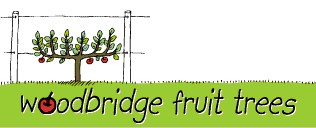No products
 View larger
View larger
Espaliering Made Even Easier - KNNN method
by Bob Magnus | © 2006 Woodbridge Fruit Trees | www.woodbridgefruittrees.com.au
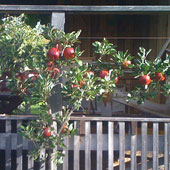
****** THIS METHOD IS NO LONGER RECOMMENDED and is displayed here for historical purposes only. Please use the Horizontal T method instead *******
You may have noticed that there is a quiet revolution happening in gardening in Australia. It may have something to do with the environment and it may have something to do with the industrialisation of the way much of our food is produced.
Many people are genuinely trying to produce some part of their own food in their own gardens or patios to free themselves from the barcode food cycle upon which we have become too dependant. A few hens (no rooster though), fruit trees on the front lawn, even on the nature strip are now considered OK. We are slowly 'coming out' and vegetables and fruit are no longer relegated to 'down the back'. Schools are starting vegetable and fruit gardens in order to give our kids at least an idea how food is produced and to show them that it isn’t necessarily a stigma to cultivate the ground. It’s not 'dirt' - it’s the earth - we ‘re telling them and it’s rich and vital and it’s from where our whole life comes.
My small part in this revolution has been to spend my life growing fruit trees: for the first half subtropical ones and the second half temperate climate ones and it has been a rich and fascinating journey. After growing apples here for the last 25 years and espaliers for the last 15 or so I have learnt a lot and the KNNN method is the culmination and refinement of my experience. It is a system that permits the gardener to produce lots of fruit in a very small area and over a season of 6 or more months of the year. This technique is possibly not the difinitive method - in another 15 years or so there may be more refinements or development. Amen, I say and lets keep them coming.
Even though I have worked this system out by myself it is not new. Since the Middle Ages and even before, initially the Italians and French, then the Germans and English have been using restricted forms of fruit trees and it was by the Catholic Church and with the monastery system through the centuries that these growing methods have spread through Europe. Who knows? Maybe the lack of monasteries and the wide-open spaces of Australia weren’t fertile territory for constricted forms of anything - we never had the need to look inwards. We always had a broad horizon - a big view.
It’s this exuberance of nature, the toughness of the Australian fauna that is part of the problem. The possums, parrots, wallabies, currawongs and wattlebirds - not to mention the ones that came with us: the rabbits, the blackbirds, starlings and snails all want a share of the fruit we grow. Actually it is us that have to share with THEM and if they get a chance they will take the LOT!
The KNNN way of growing fruit not only permits you to grow many varieties in a small area, it also is very easy to cover then up with a net as the fruit matures, so you get the lot and not the wildlife. This intensive growing system is entirely dependant on finding and growing trees on dwarfing rootstocks. If you go to Bunnings or Big W and buy a big fat granny Smith or Golden Delicious tree - sorry, they wont help us here. There are a few select nurseries producing dwarf trees and these have to be searched out. As dwarf trees aren’t as impressive as big fruit trees with glossy labels in supermarket style garden centres, they are often overlooked as runts or 2nd quality trees - but this is not so. They are the culmination of sophisticated plant breeding that gives growers yields of 3 or 4 times more fruit than in conventional orchards. But they are not set and forget plants - this growing method is as demanding as the body parts that give it its name! But if you follow my directions you will be well rewarded with more fruit than your family can eat - or drink.
The most obvious and radical difference between this method and conventional growing is that it’s a non-pruning method. Australians just love pruning and just can’t wait until winter to get out those secateurs and get into it. If you are one of those - sorry, you are not with us. The minimal pruning done in the KNNN method is done in summer (see separate article). Winter is for contemplation, looking at seed and fruit tree catalogues, planting yet more trees and eating and drinking the stored up preserved fruit of last years harvest.
THE TECHNIQUE
The 4 afore-mentioned body parts i.e. knee, navel, nipple and nose refer simply to the heights of the 4 wires used in this espalier system (disappointed? I hope not).
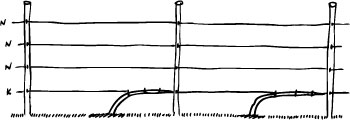
Fig. 1 In winter at planting time the young tree is set out at 45 degree and tied loosely to the bottom wire in 2 or 3 places.
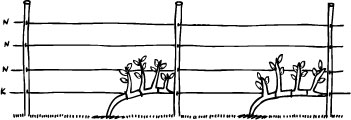
Fig. 2 In the first growing season many shoots will arise from the main stem.
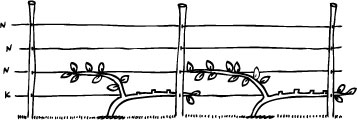
Fig. 3 The strongest (or first) shoot is taken to the second wire and the rest cut away to a first or second bud.
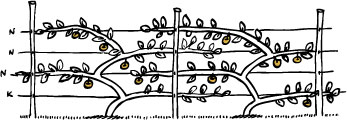
Fig. 4 In subsequent years the process is repeated.Train and tie the strongest leader to the next wire and remove the rest.
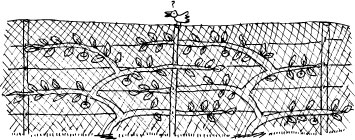
Fig. 5 When the fruit starts to mature it is easy to cut away the young upright growth on the top row and cover the lot with a net.
This system is very flexible - if you are a shortie your espalier will be shorter and lower. If you happen to be a 2 m basketball player type, the distance between the wires will reflect this. The trellis is equally good free standing or against a fence or wall. There has to be plenty of light though - at least 1/2 a day’s sunlight. The planting distance is 2m between each tree.
This creates an informal espalier with absolutely minimum pruning. You just cut away the surplus upright shoots each year and tie down the outermost growing tip further along each wire.
You’ll be amazed and gratified how decorative this growing method is and how early (often in the first year) these little trees start to flower and produce fruit. Don’t pull these fruits off! The little tree is doing it just for you and early cropping tends to set the tree into a cycle of fruiting rather than one of growing more branches. Compensate rather by giving it more mulch, cow manure, TLC and attention. You’ll find that your relationship (KNNN) will become stronger and more intimate over the years and your Gravenstein, Andre Sauvage, Ribston Pippin or Cat’s Head will respond ever better to the attention you give it. But don’t forget that this little tree is totally dependent upon YOU for it’s wellbeing. If you cater to it’s needs you’ll be repaid many times over by abundant crops of fruit.
Two more small points.
You can plant these trees in rows of different ripening times: first row ripening in January and February, the second row ripens midseason and the third is for late ripening ones. There is a lot of flexibility here: if you have a big family and make lots of cider and pies you may wish to have a row of 10 earlies, 10 mids and 10 lates, or if you are a little old couple like us maybe 2 of each would be sufficient. If you keep equal numbers in each row you’ll only have to buy one net - when you’ve picked the earlies, move the net to the mid-seasons and finally to the late ones. Our nets are now not far from 20 years old and should last a good while yet.
Second point: This system lends itself perfectly to drip irrigation. Even in the most arid areas you shouldn’t suffer from lack of water. Along the Knee wire a 12 mm black low pressure poly pipe is attached and a dripper inserted just above each tree. I find the absolute minimum dripper say 1 litre per hour is adequate. With an efficient filter you can even use grey water and only an absolute minimum pressure is required. Waterlines are off the ground and away from mowers and whipper-snippers (whoops!). As the trees grow, the original dripper can be blocked up and 2 new drippers inserted in the line 30-40 cm away and on either side of the main trunk.
So before you plant your next orchard, think about it. Espaliers work well for us and we hope they do for you too.
This product is no longer in stock
by Bob Magnus | © 2006 Woodbridge Fruit Trees | www.woodbridgefruittrees.com.au

****** THIS METHOD IS NO LONGER RECOMMENDED and is displayed here for historical purposes only. Please use the Horizontal T method instead *******
You may have noticed that there is a quiet revolution happening in gardening in Australia. It may have something to do with the environment and it may have something to do with the industrialisation of the way much of our food is produced.
Many people are genuinely trying to produce some part of their own food in their own gardens or patios to free themselves from the barcode food cycle upon which we have become too dependant. A few hens (no rooster though), fruit trees on the front lawn, even on the nature strip are now considered OK. We are slowly 'coming out' and vegetables and fruit are no longer relegated to 'down the back'. Schools are starting vegetable and fruit gardens in order to give our kids at least an idea how food is produced and to show them that it isn’t necessarily a stigma to cultivate the ground. It’s not 'dirt' - it’s the earth - we ‘re telling them and it’s rich and vital and it’s from where our whole life comes.
My small part in this revolution has been to spend my life growing fruit trees: for the first half subtropical ones and the second half temperate climate ones and it has been a rich and fascinating journey. After growing apples here for the last 25 years and espaliers for the last 15 or so I have learnt a lot and the KNNN method is the culmination and refinement of my experience. It is a system that permits the gardener to produce lots of fruit in a very small area and over a season of 6 or more months of the year. This technique is possibly not the difinitive method - in another 15 years or so there may be more refinements or development. Amen, I say and lets keep them coming.
Even though I have worked this system out by myself it is not new. Since the Middle Ages and even before, initially the Italians and French, then the Germans and English have been using restricted forms of fruit trees and it was by the Catholic Church and with the monastery system through the centuries that these growing methods have spread through Europe. Who knows? Maybe the lack of monasteries and the wide-open spaces of Australia weren’t fertile territory for constricted forms of anything - we never had the need to look inwards. We always had a broad horizon - a big view.
It’s this exuberance of nature, the toughness of the Australian fauna that is part of the problem. The possums, parrots, wallabies, currawongs and wattlebirds - not to mention the ones that came with us: the rabbits, the blackbirds, starlings and snails all want a share of the fruit we grow. Actually it is us that have to share with THEM and if they get a chance they will take the LOT!
The KNNN way of growing fruit not only permits you to grow many varieties in a small area, it also is very easy to cover then up with a net as the fruit matures, so you get the lot and not the wildlife. This intensive growing system is entirely dependant on finding and growing trees on dwarfing rootstocks. If you go to Bunnings or Big W and buy a big fat granny Smith or Golden Delicious tree - sorry, they wont help us here. There are a few select nurseries producing dwarf trees and these have to be searched out. As dwarf trees aren’t as impressive as big fruit trees with glossy labels in supermarket style garden centres, they are often overlooked as runts or 2nd quality trees - but this is not so. They are the culmination of sophisticated plant breeding that gives growers yields of 3 or 4 times more fruit than in conventional orchards. But they are not set and forget plants - this growing method is as demanding as the body parts that give it its name! But if you follow my directions you will be well rewarded with more fruit than your family can eat - or drink.
The most obvious and radical difference between this method and conventional growing is that it’s a non-pruning method. Australians just love pruning and just can’t wait until winter to get out those secateurs and get into it. If you are one of those - sorry, you are not with us. The minimal pruning done in the KNNN method is done in summer (see separate article). Winter is for contemplation, looking at seed and fruit tree catalogues, planting yet more trees and eating and drinking the stored up preserved fruit of last years harvest.
THE TECHNIQUE
The 4 afore-mentioned body parts i.e. knee, navel, nipple and nose refer simply to the heights of the 4 wires used in this espalier system (disappointed? I hope not).

Fig. 1 In winter at planting time the young tree is set out at 45 degree and tied loosely to the bottom wire in 2 or 3 places.

Fig. 2 In the first growing season many shoots will arise from the main stem.

Fig. 3 The strongest (or first) shoot is taken to the second wire and the rest cut away to a first or second bud.

Fig. 4 In subsequent years the process is repeated.Train and tie the strongest leader to the next wire and remove the rest.

Fig. 5 When the fruit starts to mature it is easy to cut away the young upright growth on the top row and cover the lot with a net.
This system is very flexible - if you are a shortie your espalier will be shorter and lower. If you happen to be a 2 m basketball player type, the distance between the wires will reflect this. The trellis is equally good free standing or against a fence or wall. There has to be plenty of light though - at least 1/2 a day’s sunlight. The planting distance is 2m between each tree.
This creates an informal espalier with absolutely minimum pruning. You just cut away the surplus upright shoots each year and tie down the outermost growing tip further along each wire.
You’ll be amazed and gratified how decorative this growing method is and how early (often in the first year) these little trees start to flower and produce fruit. Don’t pull these fruits off! The little tree is doing it just for you and early cropping tends to set the tree into a cycle of fruiting rather than one of growing more branches. Compensate rather by giving it more mulch, cow manure, TLC and attention. You’ll find that your relationship (KNNN) will become stronger and more intimate over the years and your Gravenstein, Andre Sauvage, Ribston Pippin or Cat’s Head will respond ever better to the attention you give it. But don’t forget that this little tree is totally dependent upon YOU for it’s wellbeing. If you cater to it’s needs you’ll be repaid many times over by abundant crops of fruit.
Two more small points.
You can plant these trees in rows of different ripening times: first row ripening in January and February, the second row ripens midseason and the third is for late ripening ones. There is a lot of flexibility here: if you have a big family and make lots of cider and pies you may wish to have a row of 10 earlies, 10 mids and 10 lates, or if you are a little old couple like us maybe 2 of each would be sufficient. If you keep equal numbers in each row you’ll only have to buy one net - when you’ve picked the earlies, move the net to the mid-seasons and finally to the late ones. Our nets are now not far from 20 years old and should last a good while yet.
Second point: This system lends itself perfectly to drip irrigation. Even in the most arid areas you shouldn’t suffer from lack of water. Along the Knee wire a 12 mm black low pressure poly pipe is attached and a dripper inserted just above each tree. I find the absolute minimum dripper say 1 litre per hour is adequate. With an efficient filter you can even use grey water and only an absolute minimum pressure is required. Waterlines are off the ground and away from mowers and whipper-snippers (whoops!). As the trees grow, the original dripper can be blocked up and 2 new drippers inserted in the line 30-40 cm away and on either side of the main trunk.
So before you plant your next orchard, think about it. Espaliers work well for us and we hope they do for you too.
Reviews
No customer reviews for the moment.
